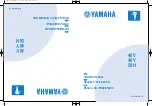To o l St i c k - C a p To u c h S e n s e D C
Rev. 0.3
11
9. Using the CapTouchSense Daughter Card as a Development Platform
The prototyping area on the ToolStick CapTouchSense Daughter Card makes it easy to interface to external
hardware. All of the digital I/O pins of the C8051F931 MCU are available so it is possible to create a complete
system.
9.1. C8051F931 Pin Connections
It is important to note that if external hardware is being added, some of the existing components on the board can
interfere with the signaling. The following is a list of port pins on the C8051F931 that are connected to other
components:
P0.2—This pin is connected to the P0.2 switch. The switch and R10 can be safely removed from the daughter
card if they are not needed.
P0.0, P0.1, P0.3, P1.2—These pins are connected to capacitive touch sense switches. The 0
resistors R15,
R17, R18, and R19 be safely removed from the daughter card if the capacitive touch sense switches are not
needed.
P0.4, P0.5—These pins are connected directly to the ToolStick Base Adapter for UART communication.
P1.0, P1.1—These pins are connected directly to the ToolStick Base Adapter’s GPIO pins. By default, these
GPIO pins on the Base Adapter are high-impedance pins so they will not affect any signaling. Configuring these
pins on the Base Adapter to output pin or handshaking pins could affect signaling.
P1.3—This pin is connected to the power source detect signal.
P1.0—This pin is connected to the cathode (-) of the blue LED on the daughter card. The LED or R23 resistor
can be removed to disconnect the LED from the pin.
P1.1—This pin is connected to the cathode (-) of the green LED on the daughter card. The LED or R24 resistor
can be removed to disconnect the LED from the pin.
P1.5—This pin is connected to the cathode (-) of the red LED on the daughter card. The LED or R5 resistor can
be removed to disconnect the LED from the pin.
P1.6—This pin is connected to the cathode (-) of the yellow LED on the daughter card. The LED or R4 resistor
can be removed to disconnect the LED from the pin.
See the daughter card schematic in Section 12 for more information.
9.2. VREF Capacitor
On the C8051F931 devices, if VREF is generated using the High-Speed Internal Reference, no output capacitor is
required. If using the on-chip Precision Voltage Reference, it is highly recommended to place a capacitor on the
VREF output pin. On the ToolStick CapTouchSense Daughter Card, there are pads on the board (C5) to populate a
0603 surface mount capacitor. There are also pads on the board (R14) to facilitate shorting P0.1 to the ground
plane for use as an analog ground reference (AGND). The firmware examples for the daughter card use the High-
Speed Internal Reference as VREF and the GND pin as a ground reference, so no external capacitor on P0.0 is
necessary for proper operation. Also, P0.1 may be used for general purpose I/O.
9.3. C2 Pin Sharing
On the C8051F931, the debug pins, C2CK, and C2D, are shared with the pins /RST and P2.7 respectively. The
daughter card includes the resistors necessary to enable pin sharing which allow the /RST and P2.7 pins to be
used normally while simultaneously debugging the device. See Application Note “AN124: Pin Sharing Techniques
for the C2 Interface” at


















